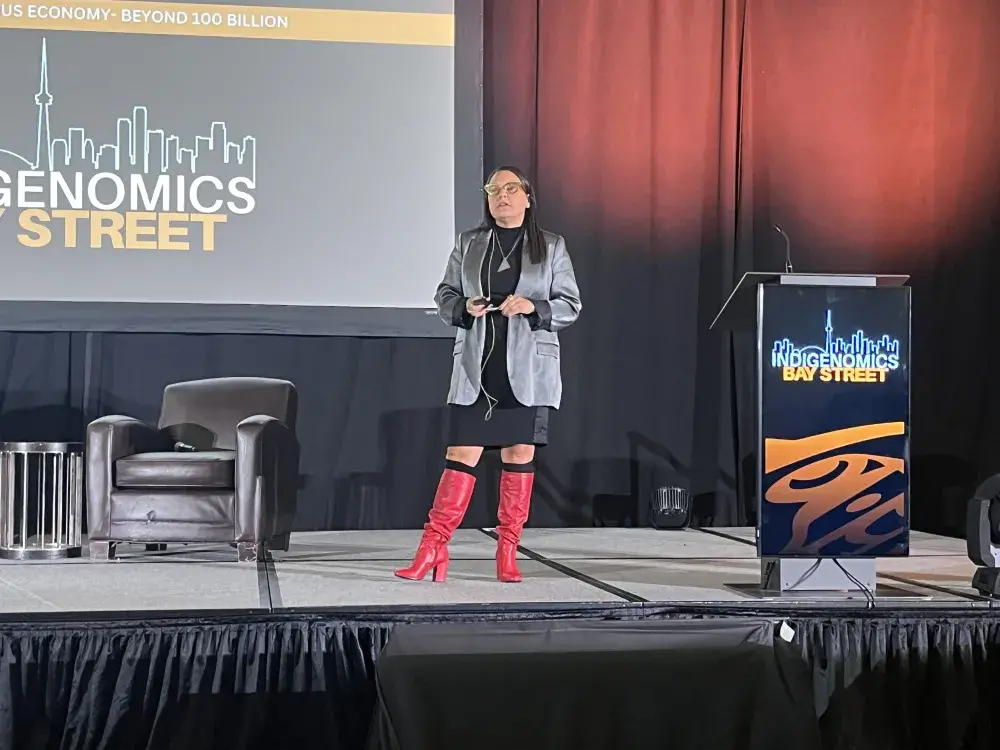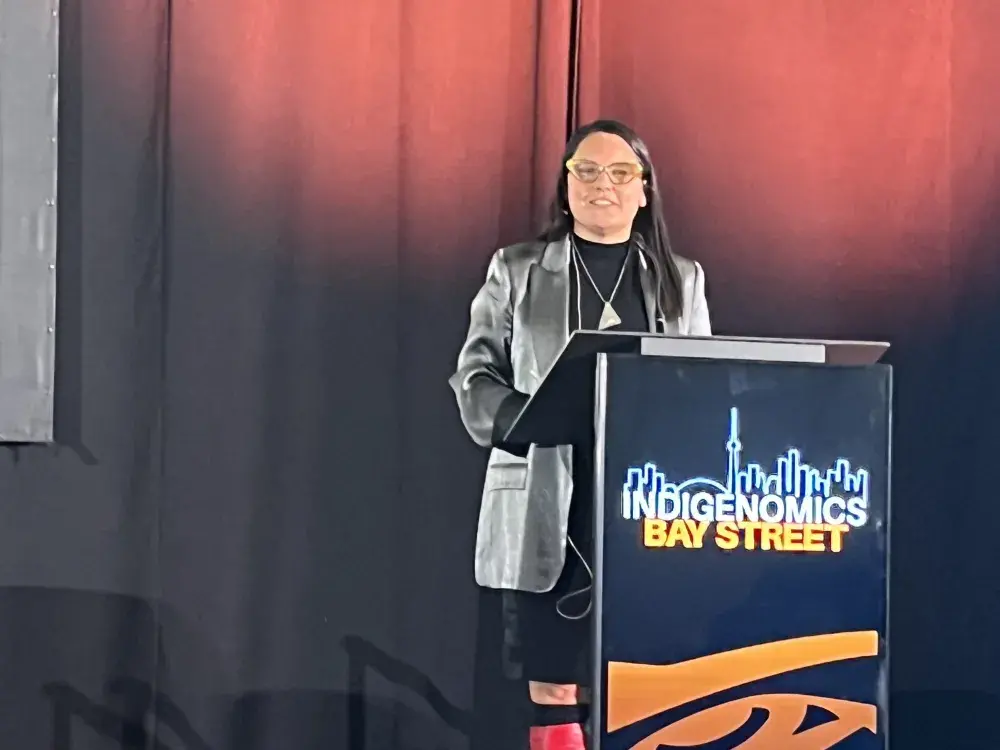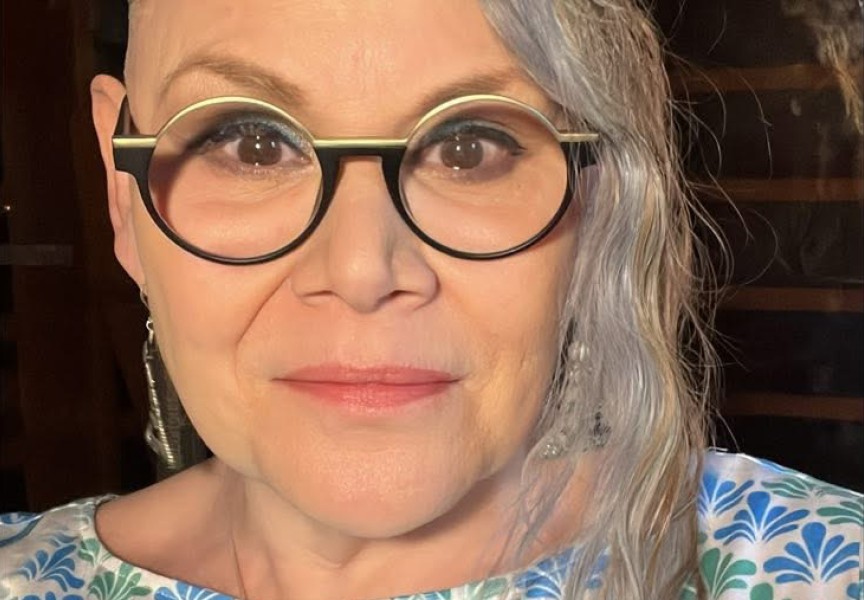Canadian commerce is in a paradoxical state with two economies existing; the mainstream while another operates according to the Indian Act.
This is part of what’s put forth in Carol Anne Hilton’s next book, which will not be publicly available until April of 2025. But Hilton, a member of Hesquiaht First Nation, has provided plenty of glimpses of material that will be included in her second book.
Details of Hilton’s upcoming book were discussed while she delivered a keynote address at the Indigenomics Bay Street conference, which concluded on Oct. 18 in Toronto. Hilton’s address was titled Beyond Indian Act Economics - Framing The Rise of Indigenous Economic Power.
The first book Hilton wrote, published in 2021, became a bestseller and was called Indigenomics: Taking a Seat at the Economic Table. That book focused on how the economy is seen and understood from an Indigenous worldview.
Hilton’s upcoming book goes in another direction.
“I assert it is time to start talking about Indian Act economics,” she said. “It is time to bring into focus this story of the rise of Indigenous economic power. The story of this moment brings into focus who we are as Indigenous people, what our collective response is to the experience of the development of Canada itself.”
During her keynote, Hilton referenced words by Duncan Campbell Scott, who back in 1913 was appointed the first superintendent of the Indian Affairs department.
“He talks about the happiest future, where the Indian race is the absorption into the general population,” Hilton said. “And this is the object of a policy of our government.”
Hilton obviously has a different view.
“I would like to assert the happiest future of our people is to be able to operate from within our worldview,” she said. “The happiest future for our people is to be able to operate within our stewardship, our responsibilities, our teachings. I think we’re successful.”
Hilton also said it is time to start having conversations about Indian Act economics.
“What is it?” she said. “How do we see it? How do we experience it? How does it feel? When we see it, how do we talk about it? It is time to start talking about Indian Act economics.”
Hilton added there are two kinds of the economy functioning right now within the country.
“The first is the economy as we understand it and we get neat, tidy reports and a matrix generated and they tell us a story about this time,” she said. “The second is Indian Act economics.”
She also said Canadian officials have Indigenous people believing that reserve land is their territory.
“Reserve land is not our territory,” she said. “It is land that is set aside for us by the federal government. Indigenous Nations have entire territories and we are the original rightsholders. If there are economic projects happening off the reserve but in the territory, the denial of our economic participation in that development, that is Indian Act economics.”
This issue needs to be more openly discussed, Hilton said.
“We need to be talking about this in the boardrooms, in our offices,” she said. “We need to be comfortable asking questions what does this mean. We need to start being uncomfortable in what it is that we don’t understand and what it is that we need to collectively understand.”
Hilton also said the Indian Act essentially facilitates an inadequate investment meant for Indigenous Nations, by creating a perception of risk for financial institutions - essentially creating a higher cost of money.
“It’s the absence of legal frameworks,” she added. “It’s the absence of Indigenous-led economic institutions. It’s the location of the reserves. It’s the population, of where we live, the externalization of decision making. All of that is Indian Act economics.”
Canada’s parliament first passed the Indian Act in 1876. Though amended over the years, it is still in effect today.
“The Indian Act is purposely designed to assimilate Indigenous people,” Hilton said. “It is meant to sever the generations. Indian Act economics is the denial of dignity of Indigenous people. It’s the foundation for the formation of the Indigenous socio-economic gap today. This Indigenous socio-economic gap in itself is an expression of the outcomes of the imposed systems of dependency through the Indian Act.”
Hilton also questioned whether the Indian Act is ethical.
“To be able to have the conversation, to bring leadership to that perspective, to be uncomfortable to have in the space that identifies what is our response if it is, if it isn’t,” she said. “This is about the response to the rise of Indigenous economic power. Canada exists in a paradox today. It is in the interplay between the release of power and control and adapting and adjusting and advancing Indigenous legal and economic environment.”
Hilton said that her upcoming book also provides details, through interviews she conducted, that Canadians are absolutely affected by the Indian Act.
“It’s just that they don’t know it, that they’re affected by it,” she said. “If the Indian Act is preventing the full participation of First Nations in the Canadian economy and if the Indian Act is limiting in any way that participation and a wealth creation and a wellbeing of Indigenous communities by virtue of these barriers, that puts to that participation Canadians are absolutely affected by it but possibly just not aware of it.”
The three-day Indigenous Bay Street conference included various other sessions. The goal of the event was to showcase the strength of the Indigenous economy and to build bridges towards economic reconciliation.








